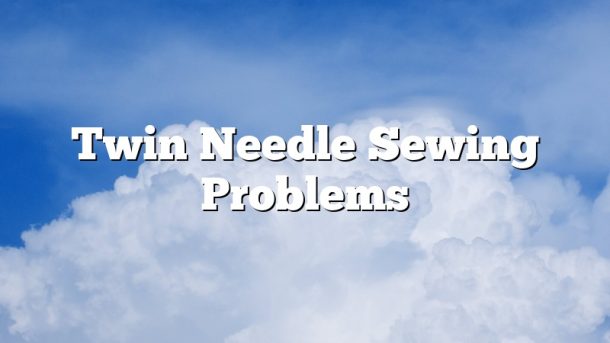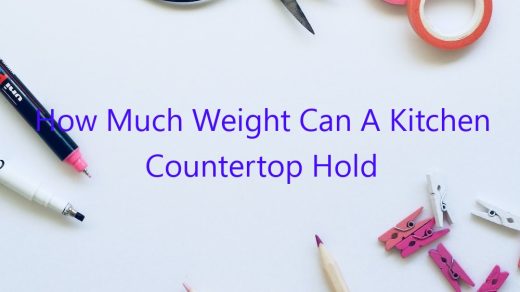Sewing with a twin needle can be a bit tricky, but with a bit of practice you’ll be a pro. Here are a few tips to help you with any twin needle sewing problems you may encounter.
The most common problem when using a twin needle is sewing in a straight line. This can be tricky, but it’s important to keep your stitches even and consistent. You may find it helpful to use a ruler or a piece of fabric as a guide.
Another common problem is getting the needles to stitch evenly. This can be caused by a number of things, such as the fabric being too thick or the needles not being properly aligned. If the needles are not properly aligned, you may find that the stitches are bunching up or that one needle is doing more of the work than the other.
If you’re having trouble getting the needles to stitch evenly, try adjusting the position of the fabric on the sewing machine. You may also need to adjust the tension on the thread. If the fabric is too thick, you can try using a thinner fabric or a needle with a smaller eye.
Finally, remember to keep your seams flat. If the seams are puckered, it will be difficult to get the stitches to look even.
Contents [hide]
Why does my twin needle skip stitches?
A twin needle is a type of sewing machine needle that has two points instead of one. This type of needle is often used to sew hems on fabric. However, sometimes a twin needle will skip stitches, which can be frustrating. There are several reasons why this might happen, and some solutions.
One possible reason for skipping stitches is that the fabric is not being held taut enough. When the fabric is loose, the needle can skip over the fabric fibers. To avoid this, make sure the fabric is taut and that the tension on the machine is set correctly.
Another reason the needle might skip stitches is if the thread is not properly threaded through the needle. Make sure the thread is going through the eye of the needle properly, and that there is no thread caught in the needle itself.
If the needle is not properly inserted into the fabric, it can also cause the needle to skip stitches. Make sure the needle is inserted all the way into the fabric, and that it is not crooked.
Finally, if the needle is too dull, it might not be able to pierce the fabric properly. In this case, you will need to replace the needle.
How do you stop a twin needle from tunneling?
If you’re using a twin needle to sew two parallel lines of stitching, you may find that the needle tunnels through the fabric, creating a hole. This can be frustrating, but there are a few ways to stop it from happening.
One way to stop a twin needle from tunneling is to use a stabilizer. A stabilizer is a thin piece of fabric that is glued to the back of the fabric to provide extra stability. This will help to keep the fabric from puckering or stretching, which can cause the needles to tunnel.
Another way to prevent tunneling is to use a thicker fabric. A thicker fabric will be less likely to stretch and will provide more stability for the needles.
Finally, you can use a shorter stitch length. A shorter stitch length will make the stitches smaller and more dense, which will help to keep the fabric from puckering.
What stitch do you use for twin needle?
When using a twin needle, it’s important to use the correct stitch. The most common stitch used is the zigzag stitch. This stitch helps to keep the fabric from puckering and helps to distribute the tension evenly.
Another stitch that can be used is the overlock stitch. This stitch is used to create a seam that is stronger and less likely to fray. It can also help to prevent the fabric from stretching.
Finally, the triple straight stitch can be used. This stitch is a strong stitch that is good for seams that need to be reinforced.
Can all sewing machines use twin needles?
Can all sewing machines use twin needles?
This is a question that is asked by many people who are new to sewing. The answer is yes, most sewing machines can use twin needles.
There are a few things you need to know before using a twin needle. The first is that the needles must be the same size. The second is that the needles must be inserted into the machine so that the two needles are aligned. This is usually marked on the machine with a diagram of two needles pointing in opposite directions.
When using a twin needle, you need to adjust the stitch width. This can be done by either turning a knob on the machine or by pressing a button. You will also need to adjust the tension. This can be done by turning a knob on the machine or by pressing a button.
twin needles can be used to create a variety of different stitches, including:
– Straight stitch
– Zigzag stitch
– Overlock stitch
– French seam
Twin needles can be a great way to add a professional touch to your sewing projects.
What are three possible causes of skipped stitches?
There are three possible causes of skipped stitches: tension, yarn, and fabric.
Tension is the amount of pressure you use when you knit or crochet. If your tension is too tight, the stitches will be too tight and will not be able to slide over each other, which will cause skipped stitches.
Yarn is another possible cause of skipped stitches. If the yarn is too thick or too thin, it will be difficult to knit or crochet with, which can also cause skipped stitches.
Fabric is the third possible cause of skipped stitches. If the fabric you are working with is too tight or too loose, it can cause skipped stitches.
How do you fix a skipping stitch?
In sewing, a skipping stitch is a common problem that can be caused by a variety of factors, including tension issues, incorrect threading, and poor fabric quality. A skipping stitch occurs when one or more stitches in the fabric are skipped, resulting in an unfinished or lopsided seam.
There are several ways to fix a skipping stitch. The most common method is to adjust the tension on the sewing machine. If the tension is too tight, the stitches will be forced too close together, which can cause them to skip. If the tension is too loose, the stitches will be too far apart, and they will also likely skip.
Another common cause of skipping stitches is incorrect threading. Make sure that the bobbin is threaded correctly, and that the thread is passing through the tension discs correctly. If the thread is not getting caught in the discs, it will likely skip stitches.
Poor fabric quality can also cause stitches to skip. Seams that are sewn with cheap or low-quality fabric are more likely to skip than seams that are sewn with high-quality fabric.
If a skipping stitch is caused by a tension issue, incorrect threading, or poor fabric quality, the best way to fix it is to adjust the settings on the sewing machine. If the machine is properly threaded and the tension is set correctly, the stitches will be less likely to skip. If the fabric is of high quality, the stitches will be less likely to skip.
If the machine is not properly threaded or the tension is not set correctly, the stitches may still skip, even if the fabric is of high quality. In this case, the only way to fix the skipping stitch is to adjust the machine settings.
It is also important to keep the fabric taut while sewing. If the fabric is too loose, the stitches will be too far apart and they will likely skip.
If a skipping stitch cannot be fixed by adjusting the machine settings, the best option is to remove the stitches and resew the seam. This can be a time-consuming process, but it is the only way to ensure that the seam is properly sewn.
Can you use a walking foot with a twin needle?
Can you use a walking foot with a twin needle?
A walking foot is a sewing foot that is used to help feed the fabric evenly through the machine. A twin needle is a needle that has two points, which makes it perfect for stitching two pieces of fabric together. So, can you use a walking foot with a twin needle?
The answer is yes, you can use a walking foot with a twin needle. However, it is important to note that the walking foot is not really necessary, as the twin needle will help keep the fabric moving evenly through the machine. The walking foot is more helpful when sewing very thick fabrics or when sewing multiple layers of fabric together.




